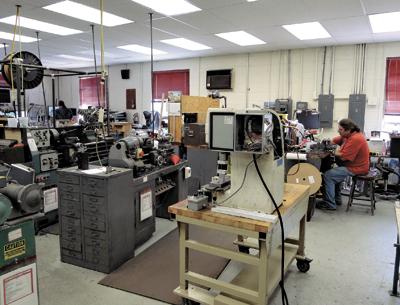A Last Bastion of Sag’s Industrial Era

Although hard to notice with the unsuspecting eye, behind the dense bushes and hedges along the Bridgehampton-Sag Harbor Turnpike lies one of Sag Harbor’s last industrial manufacturers. Founded in 1946 by Charles Edison, son of the famous inventor Thomas Alva Edison, Sag Harbor Industries remains a landmark of a time not so long ago, when the village of Sag Harbor was known for its manufacturing capabilities. Today, the company is one of the last, if not the only, industrial-level manufacturer remaining in Sag Harbor.
At its Sag Harbor location and another in Farmville, N.C., workers create voice coils for headsets, motor windings, solenoids, custom-wound electrical coils, stators, wire harnesses, electronic assemblies, purchasing magnet wires and the like for big suppliers such as Elektrisolar in New Hampshire, the Rea Magnet Wire Company in Indiana, and Superior Essex in Georgia, and they also manufacture all the tools they use in the workplace.
“We help make other people’s products,” said David Leeney, the operations manager. “We’re deep in the industrial cycle.”
The products are shipped all over the country to companiesm large and small, particularly those in the aerospace and electronic fields, including military and government. One of Sag Harbor Industries’ biggest, and nearest, clients is the Brookhaven National Laboratory in Upton.
The Sag Harbor location, which employs nearly 50 people, most of them full time, is bustling with energy. Engineers, specialized workers, and manual laborers all toil under the same roof under a system of flexible hours originated by Edison decades ago. Employees can choose their ideal working hours as long as they make at least 40 hours per week.
Edison founded the company with the idea that “a smaller, localized manufacturer could be more productive than a larger one with a central location,” according to the company’s Web site. “He believed that a smaller operation could react quicker to adversity than a larger plant with several thousand employees.”
It started out producing small electrical coils for appliances and automobile clocks, and later expanded its scope and its physical plant. The family of one of Edison’s original partners, Paul Scheerer, eventually bought out all the shares in Sag Harbor Industries. The Scheerer family still owns it and Mr. Scheerer’s daughter, Mary Scheerer, is the company’s president.
Despite its persistence in an ever-changing economy, the company underwent some trying times when it was faced with an issue of groundwater contamination on its land in the 1990s. Sag Harbor Industries had purchased land on the eastern side of the Sag Harbor Turnpike from Nabisco Inc. After the contamination issue was discovered, Nabisco and Sag Harbor Industries signed a consent decree with the Environmental Protection Agency, agreeing, among other things, to install recovery wells to pump groundwater to a treatment system. Most of those wells have been shut down because contaminants were no longer detected, according to the company.
The North Carolina branch was added in the late 1990s to “spread things out,” Mr. Leeney said. It serves more as a manufacturing facility, while most of the executive functions — sales, marketing, and operations — remain in Sag Harbor. There is “lots of interaction between the two facilities,” Mr. Leeney said, as Ms. Scheerer prepared to leave for a flight to North Carolina.
In Sag Harbor, the operation shares the building with Joe and Liza’s Ice Cream, the Awning Company, and a separate division of Sag Harbor Industries, Dortronics Systems, which manufactures electric locking hardware for the security and door-control industries. When asked how this came about, it turns out that Mr. Scheerer had always wanted his own product, and this was how the idea of Dortronics Systems was started. The combined value of both companies in revenue is around $7 million, according to Mr. Leeney.
